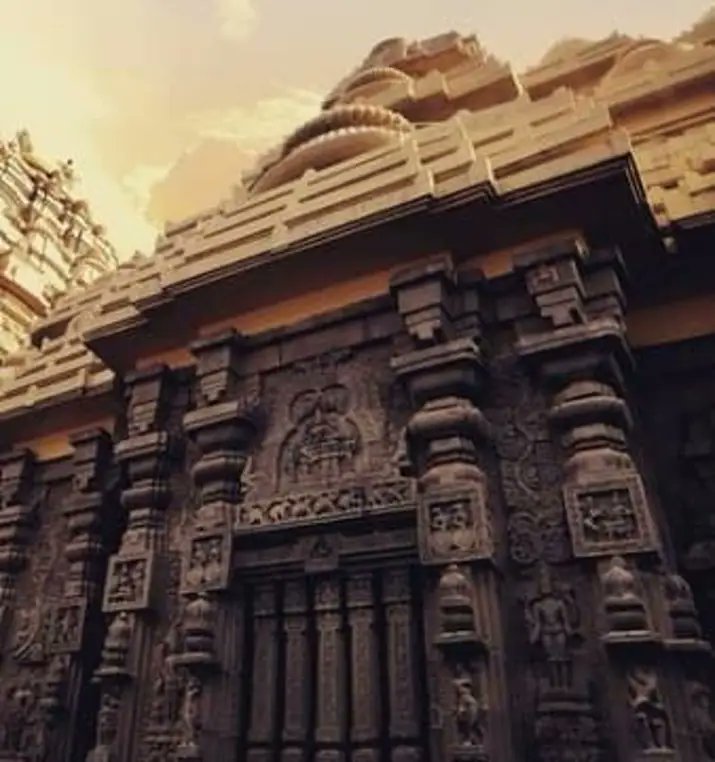A small thread of Kalinga Shilpashastra~
A number of local documents written around 1000 AD gives valuable information on the architecture of Odisha.
The most famous are the "Shilpa Prakasha" and the "Shilpa Bhubanapradipa" which describe
1/n
A number of local documents written around 1000 AD gives valuable information on the architecture of Odisha.
The most famous are the "Shilpa Prakasha" and the "Shilpa Bhubanapradipa" which describe
1/n

two types of sanctum: the rekha with a square cella and the pidha and khakhara with a rectangular cella. The latter was the preferred design in temples dedicated to Shakti, the supreme goddess.
2/n
2/n

Deula (temples) in Bhubaneswar are generally divided into two sections: the garbhagriha (cella) and the jagamohana (pavilion of the faithful) between which there may run an antarala (connecting hall). In most cases, the cella is covered by a
3/n
3/n

curved shikhara known as a rekha from which the terms rekha deul ("large temple") is derived; these descriptions refer to the sacrarium and its covering. As mentioned above, there is a less common variant in
4/n
4/n
which the cella is rectangular and is topped by a structure with an oblong vault known as khakhara taken from the local name for a cucumber. The khakhara deul is therefore a temple covered by a vault with a crown that resembles a sort of half cucumber or half it boat.
5/n
5/n
The jagamohana - also known as a mukhashala - is topped by degrading horizontal slabs called pirha from which the term pirha deul refers to the pavilion and its entire covering. The garbhagriha and jagamohana in the most important temples had two additional sections:
6/n
6/n

the natamandira (dancing pavilion) and the bhogamandapa (offerings room). The deul and the jagamohana were divided into four horizontal sections:
• The pishta (platform) formed by several mouldings
• The bara (walls)
• The gandi (covering) which is formed by bhumi
7/n
• The pishta (platform) formed by several mouldings
• The bara (walls)
• The gandi (covering) which is formed by bhumi
7/n

In large temples, and by one or more layers of pidha (pyramidal slabs) in jagamohana.
The weight of the rekha is distributed on a series of empty rooms with flat roofs known as ratnamuda.
The topmost section, mastaka, is divided into the beki (the neck of the column);
8/n
The weight of the rekha is distributed on a series of empty rooms with flat roofs known as ratnamuda.
The topmost section, mastaka, is divided into the beki (the neck of the column);
8/n

the amla or amalaka (the spherical cap); and the khapuri, the spherical vault which supports the kalasha (water vase). A further bell-shaped element, the ghanta, is inserted on the jagamohana in the mastaka between the beki and the amla.
9/n
9/n

The walls of the cella are decorated with protruding sections known as paga or ratha;the number of paga determines the type of temple which are called either triratha, pancaratha,saptaratha or navaratha referring to whether it has 3,five,seven or nine sections jutting out
10/n
10/n

The term ratha is derived from processional chariots and suggests that the off-sets conveyed the gods out of the cella so that the faithful can see them. The series of protrusions and recesses also
continues along the sides of the shikhara.
11/n
continues along the sides of the shikhara.
11/n
The central paga (called bhadra while the smaller protrusions are known as raha) often attains notable dimensions and may be decorated with niches accommodating statues. A large sculptural feature carved with a well-balanced relationship between its volumes and recesses,
12/n
12/n
the curved shikhara is mostly latina in type in which the various components wrap around one another in the same manner as climbing plants (lata) wrap themselves around host plants. The latina shikhara has a square ground plan in which little amalaka or amla
13/n
13/n
divide the tower into horizontal sections without interrupting the upthrust of the parabolic curve. Gavaksha ("arches of the sun") simulate small skylights and
14/n
14/n
became increasingly stylised and spread across the shikhara until they came to cover the tower with a grid of vibrant colours and shadows.
To be continued...
Credit:Amar Reddy
To be continued...
Credit:Amar Reddy

• • •
Missing some Tweet in this thread? You can try to
force a refresh




























